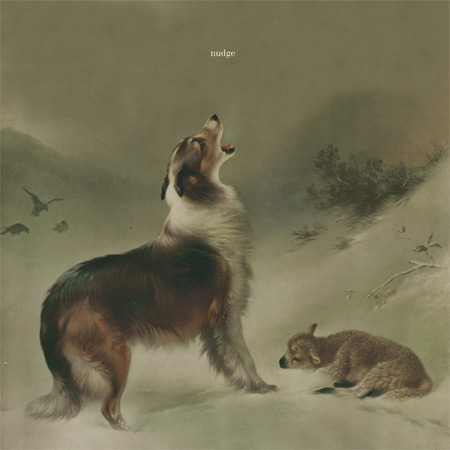Nudge, "As Good As Gone"
 Brain Foote, along with Honey Owens, Paul Dickow, and a few new faces, have produced one of the most varied and unique records I've heard all year. The progress won on their Infinity Padlock EP has been further refined into a near seamless blend of miscellaneous musical styles and sleek, spaced-out atmospheres. With As Good As Gone Nudge has entered a world all their own; nobody else sounds quite like they do.
Brain Foote, along with Honey Owens, Paul Dickow, and a few new faces, have produced one of the most varied and unique records I've heard all year. The progress won on their Infinity Padlock EP has been further refined into a near seamless blend of miscellaneous musical styles and sleek, spaced-out atmospheres. With As Good As Gone Nudge has entered a world all their own; nobody else sounds quite like they do.
Initially, it isn't clear what Foote and company are up to on their latest record. The opening song, "Harmo," is a wheezing stretch of noise that never quite gels or finds a groove. It is held together in only the most abstract way: there are no strong rhythms, identifiable lyrics, or particularly notable sonic events, nor is there a particularly strong melody to which one might latch. Honey Owens' voice merely slides in and out of intelligibility behind an orchestra of harmonica, vocal harmonies, guitar, bubbling bass, and other various electronic refuse. It develops a tangible tension, but release never comes. After listening to the album once, however, "Harmo's" place is clear: it is the sound of Nudge warming up and preparing to blow minds. Over the next 35 minutes and six songs the band fuses together dub, rocksteady, drum 'n' bass, psychedelic rock, jazz, and various forms of electronic pop and dance music. The result is a dark, almost brooding album packed full of strong songs, memorable melodies, and an enormous (somewhat sexy) low end. Through it all Nudge sound cool and relaxed, as if these peculiar blends all came to them quite naturally. I imagine the opposite is true, however. As Good As Gone shows some improvisational color, but the album's deliberate pace and sober tenor suggest that Nudge worked very hard to make this recipe sound as good as it does.
After "Harmo" shakes and buzzes away, "Two Hands" begins with a sudden rubbery bass line and a ruffled rhythm section that lends the song an uneven or unsure quality, at least at first. Strands of guitar hum to life and, shortly, Honey Owens sings a lilting tune that matches the music's lazy gait perfectly. It also generates some forward motion. Once she begins singing the song takes off in a multitude of ways. Paul Dickow's unmistakable rhythmic signature pops up almost simultaneously and is matched by both Owen's screeching guitar work and a never-ending cascade of effects, synthesizers, and instrumental variations. To top it all off, Foote inserts some muted, highly processed trumpet into the mix, tacking a distinctly jazzy tone onto the end of an already complex and luxuriant song. That hint of jazz haunts the rest of the record, sometimes showing up obviously and sometimes only vaguely. This is partly due to Nudge emphasizing continuity and development over repetition and partly due to the album's ambiguous use of otherwise familiar styles.
Aside from the repeating bass lines that anchor nearly every track on the album, loops seem to have disappeared from the band's vocabulary altogether. The drums, guitars, and synthesizers featured throughout the record grow and shrink in unexpected ways instead of simply repeating. Nevertheless, strong grooves play a big role throughout As Good As Gone, whether they are subtle or distinctly felt. On "Tito," rocksteady rhythms and unusual synthetic worms of melody produce a weightless or directionless effect, distorting time instead of keeping it. This makes the whole thing sound like a happy and drunken stroll outside a dance hall. As it turns out, the upbeat keyboard skanking, along with the pitch bending and shuffled effects, marks the brightest and happiest point on As Good As Gone. Nudge's staggered beats and confused melodies are at their most playful here. Once it ends everything goes very, very dark, like the album's artwork.
The howling dog on the cover reminds me of the slow and mournful atmosphere found on "Burns Blue" and "Dawn Comes Light." The former is a churning song with a somber bass melody and slithering vocal effects. The airy keyboards and rumbling, cymbal-heavy rhythm generate an isolated mood and further develop the jazz themes only hinted at in the previous songs. The latter is a dreamy, somewhat barren piece populated by bouts of silence and splashes of guitar strumming. It brings to mind the closing song on Infinity Padlock, but this time around the band's dynamic shift isn't nearly as surprising. The quiet guitars and near-whispered vocals eventually give way to a wave of distortion and surging, pseudo-melodious strings, which contrast the previous five songs in a relieving and natural fashion.
The ideas first tested on Infinity Padlock have matured fully by the end of this album. Nudge no longer sound as though they are forcing developments or seeking their voice. Everything has its place, even if that place is chaotic and disheveled. On As Good As Gone, the band sounds completely in control with each member performing at the height of their abilities.
samples:



